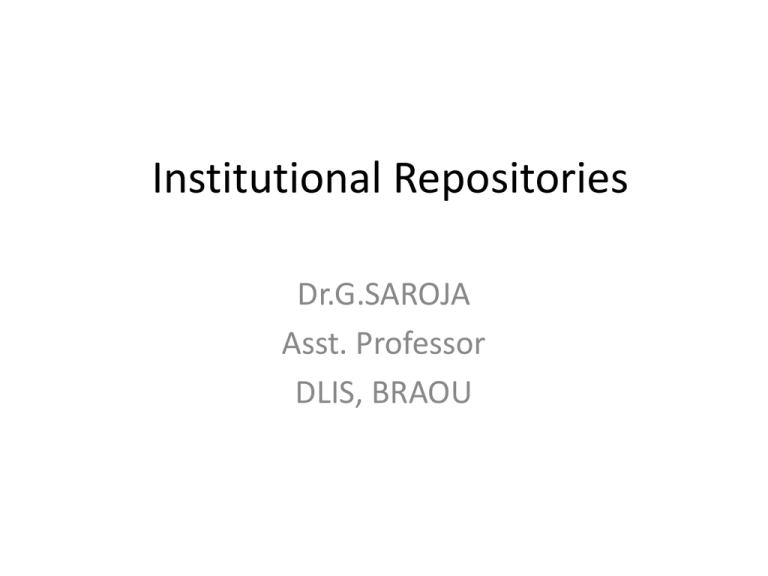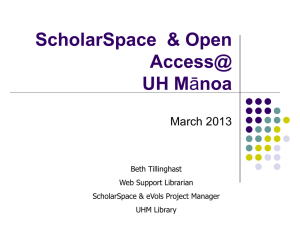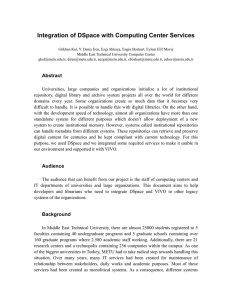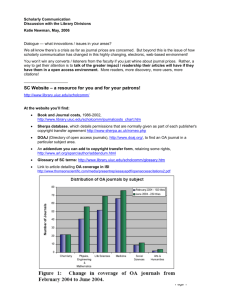Institutional Repositories - Master of Library and Information Science
advertisement

Institutional Repositories Dr.G.SAROJA Asst. Professor DLIS, BRAOU INTRODUCTION Research is the primary function of Academic & Research institutions and they are producers of primary research • Research degrees • Research projects • Publications • Conference proceedings etc. SCHOLARLY COMMUNICATION • Traditionally, publishers are doing the task of disseminating research output through the scholarly journals in various disciplines Scholarly communication has been described as comprising four essential components: • Registration—establishing the intellectual priority of an idea, concept, or research; • Certification—certifying the quality of the research and/or the validity of the claimed finding; • Awareness—ensuring the dissemination and accessibility of research, providing a means by which researchers can become aware of new research; and • Archiving—preserving the intellectual heritage for future use.6 Traditional Publishing Model • In the traditional publishing, Faculty researchers produce the original research itself; academic editors and peer-reviewers select and validate the quality and priority of the research; academic libraries process, house, and distribute the journals to end users; and library resources support archival preservation—all at little or no direct cost to the journal publishers themselves. Traditional Model The publisher contribution to the scholarly publishing value chain concentrated on the distribution component: typesetting, printing, marketing, and fulfilment were specialized and expensive tasks that authors and libraries gladly delegated to publishers. With the evolution of digital publishing and networked distribution technologies, the relative value of print production and distribution has declined. Scholarly communication in the changing times Due to the growing dissatisfaction among the academics, librarians regarding the spiraling costs of the print journals and realizing the limited role of the publishers in the process of scholarly communication, Open Access Initiatives have come into existence. It is felt that any institution with sufficient intellectual prestige and organizational standing can take up the role of publishers. Institutional Repositories thus have gained prominence in the changing technological environment. Factors that led to the development of IRs Several coinciding factors are forcing change in the structure of scholarly journal publishing: • Technological change, in the form of digital publishing technologies and ubiquitous networking, has driven the demand for broader access to research and for more robust digital presentation. • Significant increases in the overall volume of research, especially in the sciences, has strained the capacity of the print publishing model and exacerbated user dissatisfaction with the latency inherent in print publication. • Increasing dissatisfaction, especially on the part of librarians, with traditional print and electronic journal price and market models— models that have become less relevant and more difficult to sustain in a period of rapidly escalating prices and relatively flat library budgets. • Increasing uncertainty over who will handle the preservation archiving of digital scholarly research material. Institutional Repositories – definitions • An Institutional repository is an Organization based set of services which the organization offers to the members of its community for the management and dissemination of digital materials created by the institution and its community members. It is most essentially an organizational commitment to the stewardship of these digital materials, including longterm preservation, where appropriate, as well as organization and access or distribution” (Clifford Lynch 2003) • “Digital archives of intellectual products created by the faculty, staff and students of an institution or group of institutions accessible to end users both within and outside the institution.” CHARACTERISTICS OF IRs Crow (2003) and Johnson (2002) have identified four charateristics of IR. They are • Institutionally based • Scholarly material in digital formats • Cumulative and perpetual • Open and interoperable But not necessarily be free! CHARACTERISITICS OF IR – INSTITUTIONAL • Institutional Repository should focus on the content created by its constituent members. The materials could be of any one of the digital output including preprints, journal articles, lectures, learning objects and data sets etc. CHARACTERISTICS OF IR • The content should be scholarly in nature. When the material is openly accessible by the members of the community, the content should facilitate and promote further research and add to the knowledge base. The materials included in an IR can be peer reviewed journal articles, project reports funded by govt. agencies, computer programs, art works – virtually any digital material the institution wishes to preserve for the future use. CHARACTERISTICS OF IR • While creating IR the institution must develop policies to ensure that the infrastructure used to develop IR is scalable. That is, every year, lot of material will be added to the IR. Eventually, the IR should be able to store large volume of data may be in terra bytes. (Cumulative) • Once the material is deposited in the IR it can not be withdrawn unless in certain cases such as copyright infringements or plagiarism etc. However, the institutions must develop criteria and policies—and implement rights management systems—for allowing access to a repository’s content, both inside the institution and from outside, that balance the goal of the broadest available access with the reality of encouraging faculty participation. • (perpetual) IR ‘s aim to preserve and make accessible digital content on a long-term basis. The Inst. Therefore should set some standards for submission of materials by its members like – simplifying the content submission in specified file formats. Characteristics of IR • Inter-operable: (the ability to exchange and use information) "Interoperability is the ability of multiple systems with different hardware and software platforms, data structures, and interfaces to exchange data with minimal loss of content and functionality" [NISO, 2004]. In order to increase the repository access and visibility to broader research community, the IT should be able to support interoperability in order to provide access via multiple search engines and other discovery tools. It is not compulsory to implement searching and indexing functionality but IR should maintain and expose metadata, allowing other services to harvest and search the content. Why Institutional Repositories? • Institution’s visibility: IR not only serves as an indicator of quality in teaching and research but also enhances its opportunities to attract funding and advancement of research. • Digital Preservation: With the advent of robust technology, IR facilitates long term preservation of the digital content. • Open Access: WHY INSTITUTIONAL REPOSITORIES • For the Individual – Provide a central archive of their work – Increase the dissemination and impact of their research – Acts as a full CV • For the Institution – Increases visibility and prestige – Acts as an advertisement to funding sources, potential new faculty and students, etc. • For Society – Provide access to the world’s research – Ensures long-term preservation of institutes’ academic output WHY INSTITUTIONAL REPOSITORIES • Individual Benefits – Wider distribution – Showcase – Safekeeping – Lowers technology barrier – Time – Persistent URLs WHY INSTITUTIONAL REPOSITORIES • Institutional Benefits – Stewardship of scholarly output – Efficiencies through centralization – Showcase – Proactive response to scholarly communication crisis/open access movement Examples of IR : Univ. of California eScholarship Repository : http://escholarship.org/ Examples of IR : Project SHERPA – UK http://www.sherpa.ac.uk/ Examples of IR : Cornell Industrial and Labor Relations School http://digitalcommons.ilr.cornell.edu/ Examples of IR :University of Massachusets http://scholarworks.umass.edu/ Digital Commons at University of Maryland Law: http://digitalcommons.law.umaryland.edu/ Scientific Research in India • The third largest scientific and technical manpower in the world • Exclusive Government Departments for Science & Technology, Atomic Energy, Space, Electronics, Oceanography, Biotechnology… • Over 300 Research Laboratories belonging to CSIR, ICMR, ICAR, ICSSR, DRDO, ISRO… • Education/Science performed by IISc, IITs, NITs, IIMs…and most of the Medical/ Engineering/Business Schools, Universities and research labs are of international standards INSTITUTIONAL REPOSITORIES:INDIAN SCENARIO • Nearly 50 Institutions • Public Domain (Internet): 35 • Campus Network/LAN : 15 • Leading IRs • IISc, ISI, NAL, NCL, NIO, RRI, DU, IITs Sl. No. Name Host Institution URL Items Jan 2008 Soft. Used 1. Eprints@IISc Indian Institute of Science, (IISc) Bangalore. http://eprints.iisc.ernet.in/ 7672 EPrints 2. Dspace@IIMK Indian Institute of Management, Kozhikode (IIMK) http://dspace.iimk.ac.in/ 295 EPrints 3. Dspace@IIA Indian Institute of Astrophysics (IIA) http://prints.iiap.res.in/ 1903 DSpace 4. Dspace@NITR National Institute of Technology, Rourkela (IITR) http://dspace.nitrkl.ac.in/dspace/ 557 DSpace 5. ETD@IISc Indian Institute of Science (IISc) http://etd.ncsi.iisc.ernet.in/ 289 DSpace 6. Dspac@ INFLIBNET INFLIBNET http://dspace.inflibnet.ac.in 504 DSpace 7. Librarian's Digital Library (LDL) Docum. Res. & Training Centre (DRTC) https://drtc.isibang.ac.in/ 249 DSpace 8. NAL Institutional Repository Nat. Aerospace Laboratories (NAL) http://nal-ir.nal.res.in/ 2575 EPrints 9. ETheses at NCL Nat. Chemical Laboratory (NCL) http://dspace.ncl.res.in/ 407 DSpace Directories of Open Access Repositories • • • OpenDoar (http://www.opendoar.org/) • • The University of Illinois OAI-PMH Data Provider Registry (http://gita.grainger.uiuc.edu/registry/Info.asp) • • Openarchives.eu (http://www.openarchives.eu/home/home_do.aspx) • • OpCit: The Open Citation Project (http://opcit.eprints.org/opcitabout.shtml) • RoMEO (Rights /publishers.html) ROAR (http://roar.eprints.org/) MEtadata for Open archiving (http://romeo.eprints.org How does IR work • Research material is hosted and managed on an Institutional Repository server, using appropriate IR software • Accessible on the organizational LAN (intranet) + Internet/private network • Scientists use a web browser to submit (deposit) research material and also search the repository • Through OAI inter-operability protocol, a central search service ‘Harvests” metadata from individual IR’s, builds a cross-index and provides single point cross-repository search service • Security concerns could be handled at network, IR and publication level IR Technology • • • • IR software (Open Source/Commercial) OAI-PMH harvesting protocol/software (Free) Intel/Pentium servers for IR Linux/Red Hat OS, MySQL/PostGress DBMS, Apache/Tomcat web server, Perl/Java (Free) OAI-PMH harvesting protocol • It collects the OAI base path of the Inst.Repositories and passes it to the various OAI registries like – ROAR. OAI harvests can follow this registered path and retrieve the metadata for their own searching and indexing services. IR: Core Issues • Policy Decisions • Organizational Issues • Cultural Issues Policy Decisions • Scope - Multidiscipline / single subject /Entire research output /database for each functional unit • Types of documents - Single database for different types /single one • Software: OSS like DSpace or GNU Eprints or develop own • Research Deposit Types: Thesis, Journal articles, Preprints, Reports, Conference papers, Book Chapter, etc • Resources: Human (IT, Library), Servers, Funding • Stake holders: Library, Each Department, Institute as a whole • Services Management and Organizational Issues • Deposit options – - Researcher self deposit and /or assisted deposit • Metadata quality – - Ensuring quality and rich metadata is labour intensive • • • • • Mandatory metadata fields Digitization: Born digital / Scanning File formats: Accept all, Only PDF and/or other, Conversion Only full text database and/or Bibliographic Copyright: RoMeO (Rights MEtadata for Open archiving (http://romeo.eprints.org /publishers.html) Publishers Copyright policies • Quality assurance: Peer review, Editing • Deposit Agreement and Use Agreement - Depositor’s declaration: Non-exclusive license - Copyright/Patent/Trademarks - Repository’s rights and responsibilities: Distribute, Store, Migrate, Copy , Rearrange, Remove - - Use Agreement: Copy, Distribute, Display, Share, Author credit Cultural Issues • Advocacy - Sensitive to organizational culture and background - Community size - Strategy: stakeholders, management committees • Copyright - Concern of researchers, Legal department • Positioning - Library/Institute Website







